Abstract
The significance of Aeromonas spp. as potential water-borne enteric pathogens in Tasmania, Australia, an area with a mild climate and comparatively low year-round water temperatures, was investigated in view of the reported marked peak of Aeromonas-associated gastroenteritis in the summer and the apparent influence of temperature on levels of potentially pathogenic species in water supplies. Biochemical characteristics and virulence-associated properties--exotoxin production (hemolysin, enterotoxin), ability to grow at 43 degrees C, and possession of pili--were determined for 105 Tasmanian isolates of Aeromonas spp.; 43 isolates were from clinical specimens (greater than 75% diarrhea associated) and 62 were from water. Current classification schemes were evaluated for these isolates. A. sobria comprised 35% of the clinical isolates and 16% of the water isolates, A. hydrophila comprised 56 and 79%, and A. caviae comprised 9 and 5%. A total of 42% of the clinical isolates and 15% of the environmental isolates were enterotoxigenic (by the suckling mouse assay); these levels were significantly lower than those found in warmer environments. The majority (74%) of enterotoxigenic isolates were A. sobria. Enterotoxin-producing isolates possessed three or more of the following properties. They were Voges-Proskauer positive, did not hydrolyze arabinose, were positive for lysine decarboxylase, were able to grow at 43 degrees C, and produced large amounts of hemolysin (titer, greater than 128). Thus, the biochemical scheme proposed by Burke et al. (V. Burke, J. Robinson, H.M. Atkinson, and M. Gracey, J. Clin. Microbiol. 15:48-52, 1982) for identifying enterotoxigenic isolates appears to have widespread applicability. Environmental enterotoxigenic isolates possessed numerous pili, but these appeared to be lost once infection was established, as a similar isolates from patients with diarrhea were poorly piliated.
Full text
PDF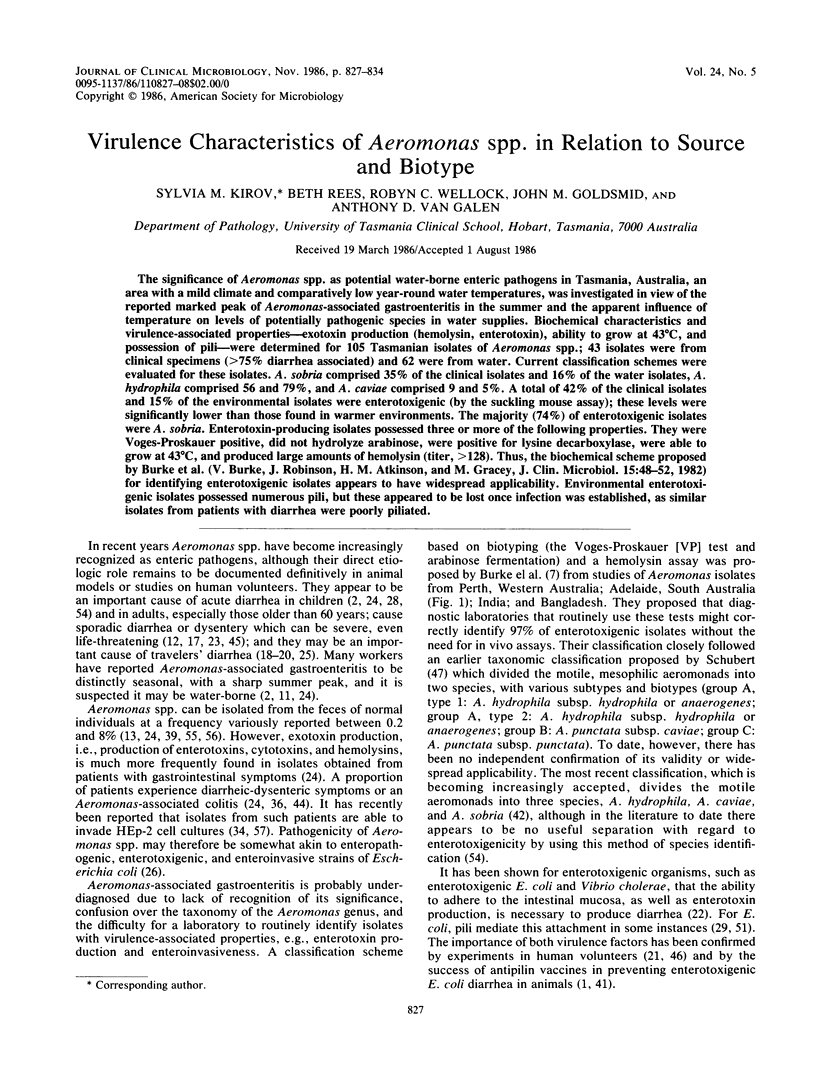
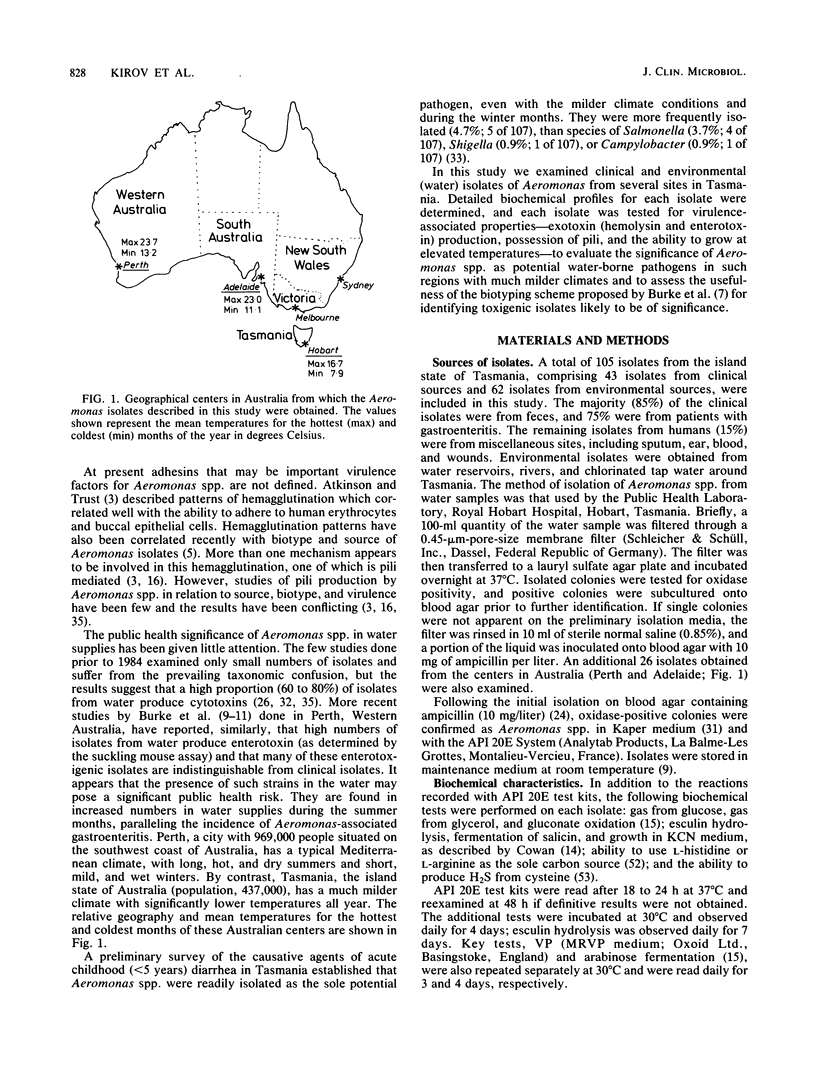
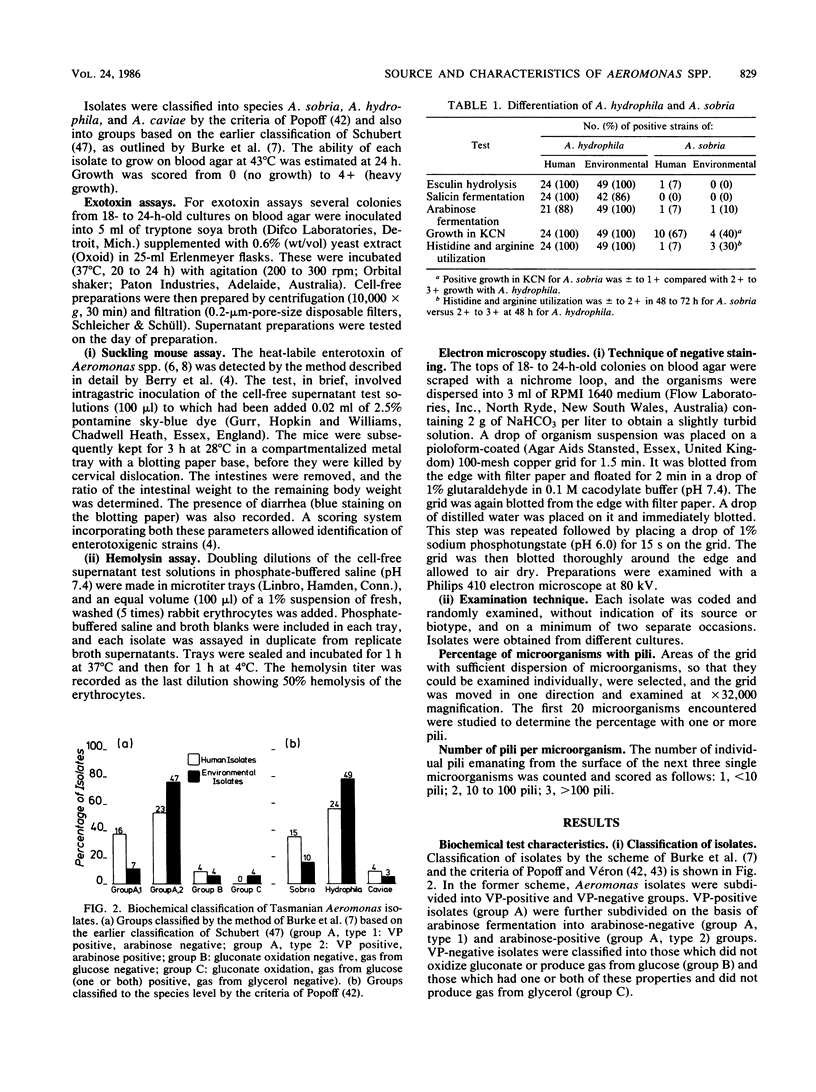
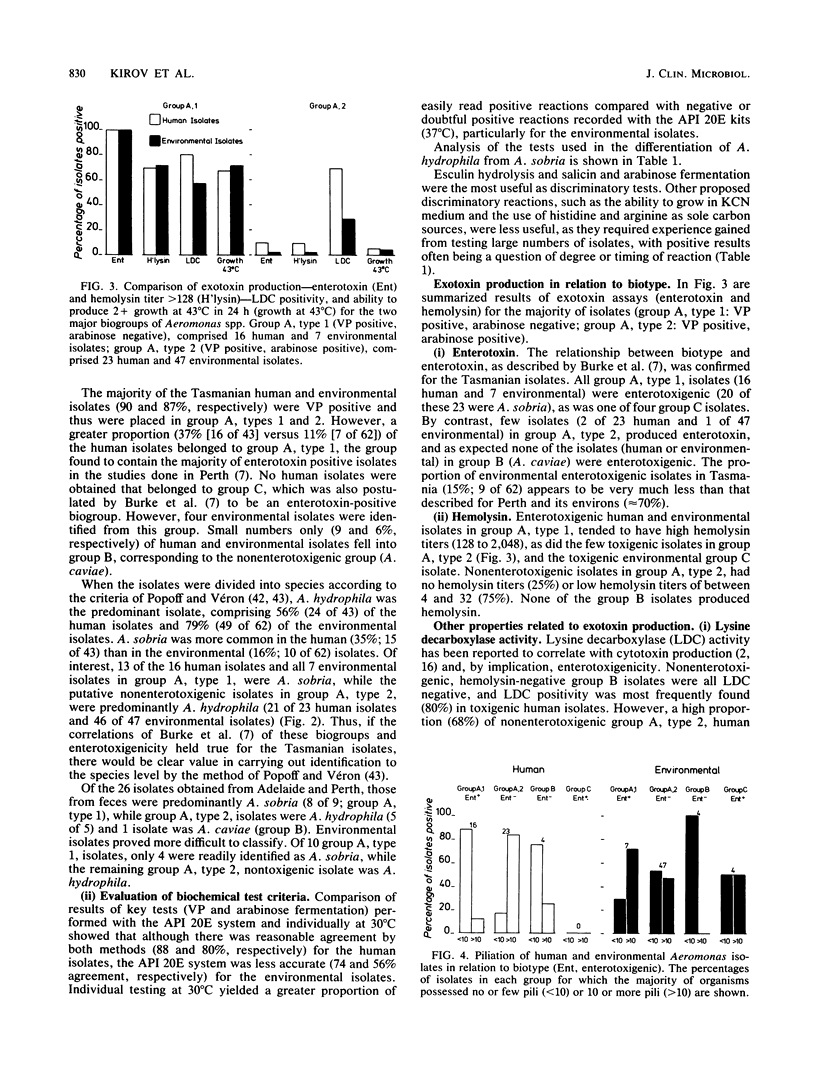

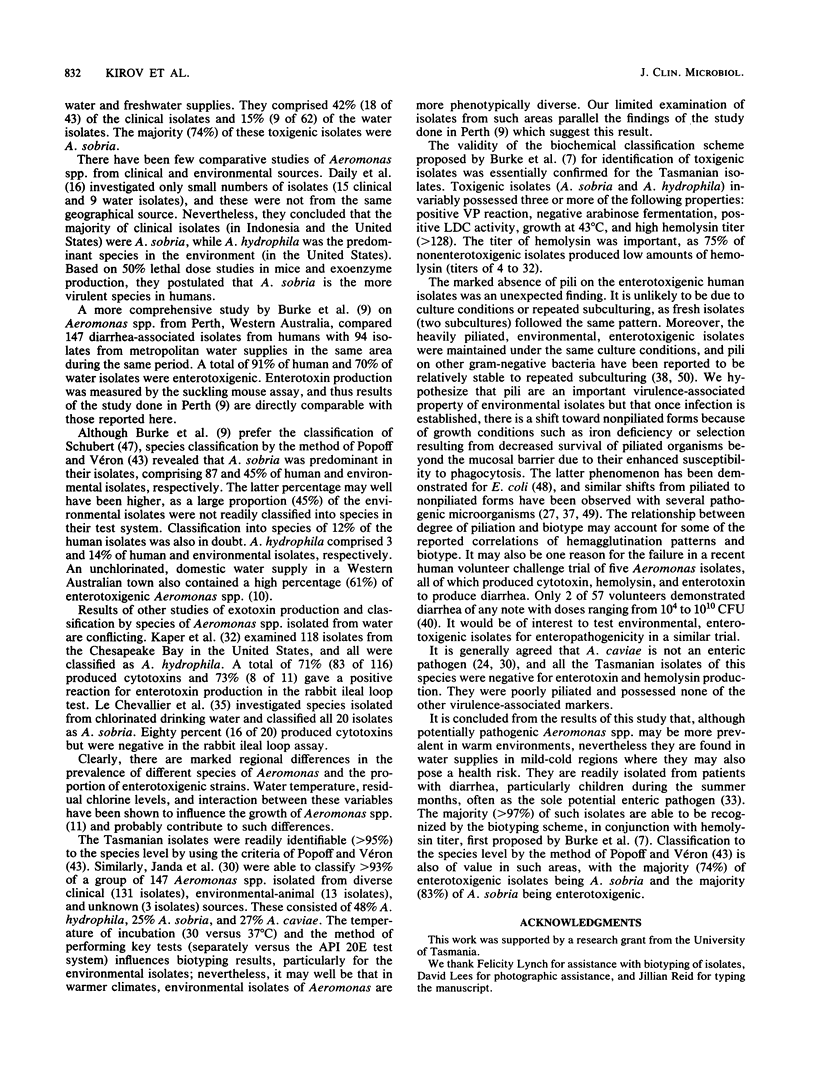
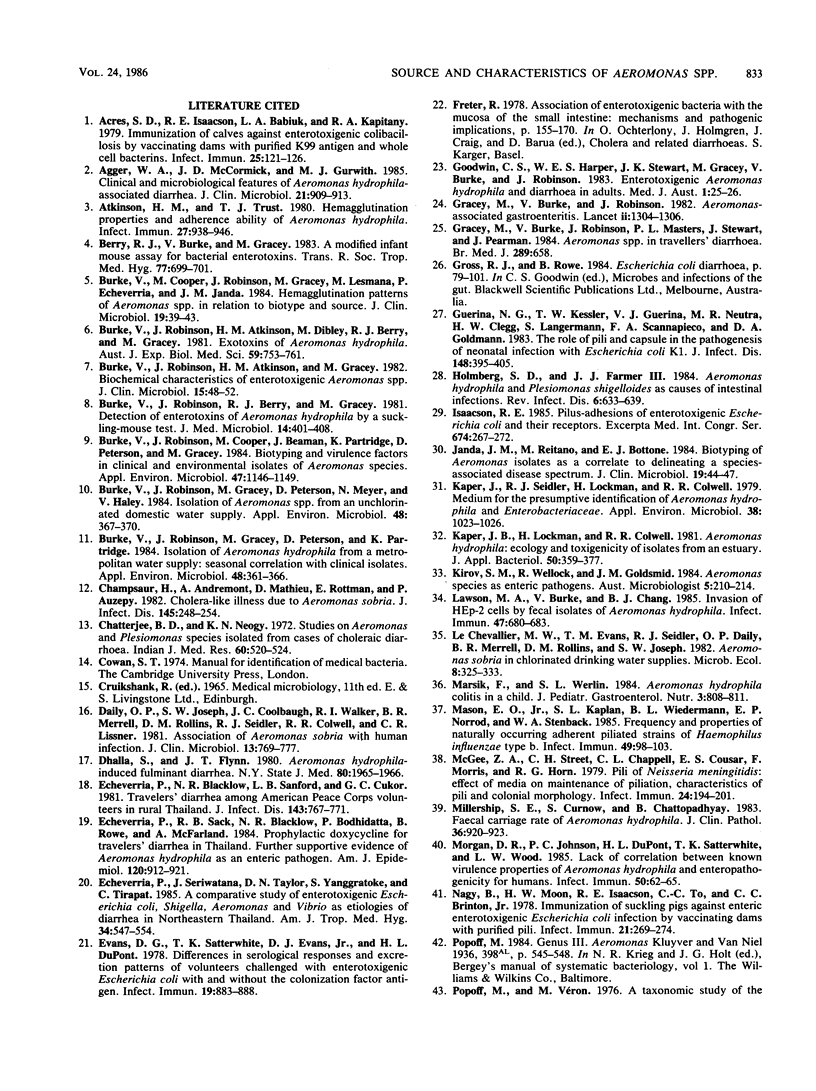
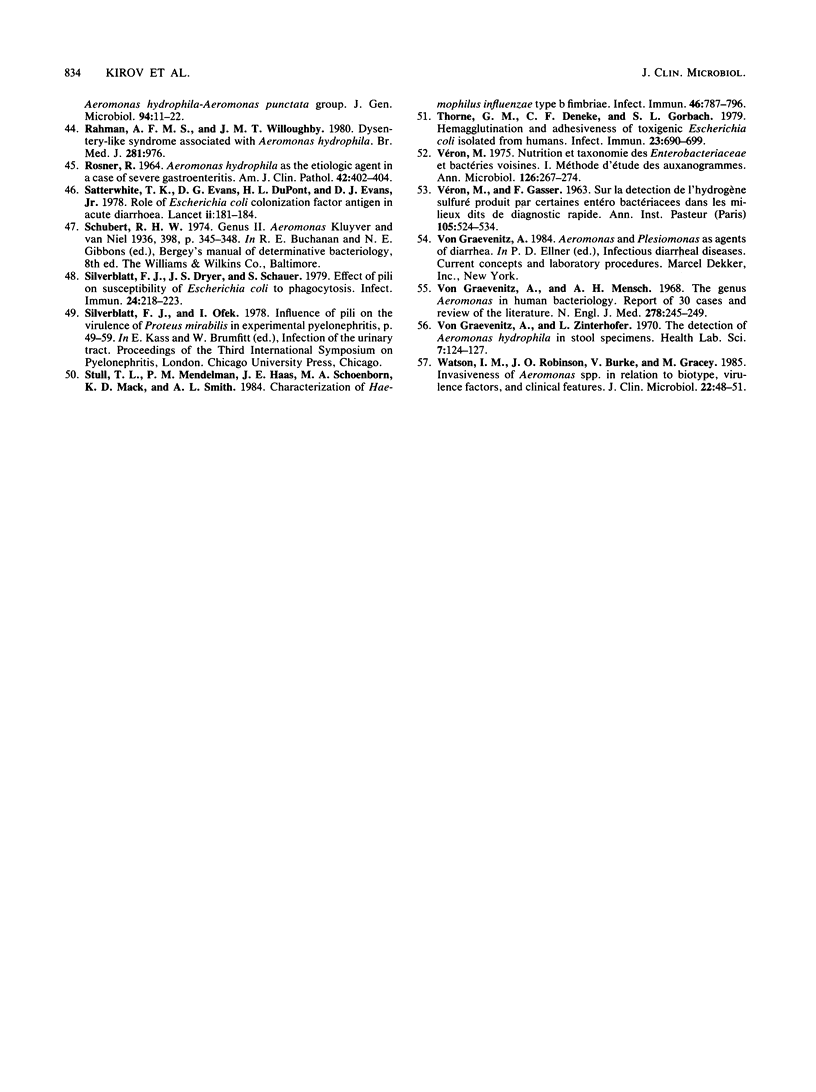
Images in this article
Selected References
These references are in PubMed. This may not be the complete list of references from this article.
- Acres S. D., Isaacson R. E., Babiuk L. A., Kapitany R. A. Immunization of calves against enterotoxigenic colibacillosis by vaccinating dams with purified K99 antigen and whole cell bacterins. Infect Immun. 1979 Jul;25(1):121–126. doi: 10.1128/iai.25.1.121-126.1979. [DOI] [PMC free article] [PubMed] [Google Scholar]
- Agger W. A., McCormick J. D., Gurwith M. J. Clinical and microbiological features of Aeromonas hydrophila-associated diarrhea. J Clin Microbiol. 1985 Jun;21(6):909–913. doi: 10.1128/jcm.21.6.909-913.1985. [DOI] [PMC free article] [PubMed] [Google Scholar]
- Atkinson H. M., Trust T. J. Hemagglutination properties and adherence ability of Aeromonas hydrophila. Infect Immun. 1980 Mar;27(3):938–946. doi: 10.1128/iai.27.3.938-946.1980. [DOI] [PMC free article] [PubMed] [Google Scholar]
- Berry R. J., Burke V., Gracey M. A modified infant mouse assay for bacterial enterotoxins. Trans R Soc Trop Med Hyg. 1983;77(5):699–701. doi: 10.1016/0035-9203(83)90209-2. [DOI] [PubMed] [Google Scholar]
- Burke V., Cooper M., Robinson J., Gracey M., Lesmana M., Echeverria P., Janda J. M. Hemagglutination patterns of Aeromonas spp. in relation to biotype and source. J Clin Microbiol. 1984 Jan;19(1):39–43. doi: 10.1128/jcm.19.1.39-43.1984. [DOI] [PMC free article] [PubMed] [Google Scholar]
- Burke V., Robinson J., Atkinson H. M., Dibley M., Berry R. J., Gracey M. Exotoxins of Aeromonas hydrophila. Aust J Exp Biol Med Sci. 1981 Dec;59(Pt 6):753–761. doi: 10.1038/icb.1981.65. [DOI] [PubMed] [Google Scholar]
- Burke V., Robinson J., Atkinson H. M., Gracey M. Biochemical characteristics of enterotoxigenic Aeromonas spp. J Clin Microbiol. 1982 Jan;15(1):48–52. doi: 10.1128/jcm.15.1.48-52.1982. [DOI] [PMC free article] [PubMed] [Google Scholar]
- Burke V., Robinson J., Berry R. J., Gracey M. Detection of enterotoxins of Aeromonas hydrophila by a suckling-mouse test. J Med Microbiol. 1981 Nov;14(4):401–408. doi: 10.1099/00222615-14-4-401. [DOI] [PubMed] [Google Scholar]
- Burke V., Robinson J., Cooper M., Beaman J., Partridge K., Peterson D., Gracey M. Biotyping and virulence factors in clinical and environmental isolates of Aeromonas species. Appl Environ Microbiol. 1984 May;47(5):1146–1149. doi: 10.1128/aem.47.5.1146-1149.1984. [DOI] [PMC free article] [PubMed] [Google Scholar]
- Burke V., Robinson J., Gracey M., Peterson D., Meyer N., Haley V. Isolation of Aeromonas spp. from an unchlorinated domestic water supply. Appl Environ Microbiol. 1984 Aug;48(2):367–370. doi: 10.1128/aem.48.2.367-370.1984. [DOI] [PMC free article] [PubMed] [Google Scholar]
- Burke V., Robinson J., Gracey M., Peterson D., Partridge K. Isolation of Aeromonas hydrophila from a metropolitan water supply: seasonal correlation with clinical isolates. Appl Environ Microbiol. 1984 Aug;48(2):361–366. doi: 10.1128/aem.48.2.361-366.1984. [DOI] [PMC free article] [PubMed] [Google Scholar]
- Champsaur H., Adremont A., Mathieu D., Rottman E., Auzepy P. Cholera-like illness due to Aeromonas sobria. J Infect Dis. 1982 Feb;145(2):248–254. doi: 10.1093/infdis/145.2.248. [DOI] [PubMed] [Google Scholar]
- Chatterjee B. D., Neogy K. N. Studies on Aeromonas and Plesiomonas species isolated from cases of choleraic diarrhoea. Indian J Med Res. 1972 Apr;60(4):520–524. [PubMed] [Google Scholar]
- Daily O. P., Joseph S. W., Coolbaugh J. C., Walker R. I., Merrell B. R., Rollins D. M., Seidler R. J., Colwell R. R., Lissner C. R. Association of Aeromonas sobria with human infection. J Clin Microbiol. 1981 Apr;13(4):769–777. doi: 10.1128/jcm.13.4.769-777.1981. [DOI] [PMC free article] [PubMed] [Google Scholar]
- Dhalla S., Flynn J. T. Aeromonas hydrophila-induced fulminant diarrhea. N Y State J Med. 1980 Dec;80(13):1965–1966. [PubMed] [Google Scholar]
- Echeverria P., Blacklow N. R., Sanford L. B., Cukor G. G. Travelers' diarrhea among American Peace Corps volunteers in rural Thailand. J Infect Dis. 1981 Jun;143(6):767–771. doi: 10.1093/infdis/143.6.767. [DOI] [PubMed] [Google Scholar]
- Echeverria P., Sack R. B., Blacklow N. R., Bodhidatta P., Rowe B., McFarland A. Prophylactic doxycycline for travelers' diarrhea in Thailand. Further supportive evidence of Aeromonas hydrophila as an enteric pathogen. Am J Epidemiol. 1984 Dec;120(6):912–921. doi: 10.1093/oxfordjournals.aje.a113962. [DOI] [PubMed] [Google Scholar]
- Echeverria P., Seriwatana J., Taylor D. N., Yanggratoke S., Tirapat C. A comparative study of enterotoxigenic Escherichia coli, Shigella, Aeromonas, and Vibrio as etiologies of diarrhea in northeastern Thailand. Am J Trop Med Hyg. 1985 May;34(3):547–554. doi: 10.4269/ajtmh.1985.34.547. [DOI] [PubMed] [Google Scholar]
- Evans D. G., Satterwhite T. K., Evans D. J., Jr, DuPont H. L. Differences in serological responses and excretion patterns of volunteers challenged with enterotoxigenic Escherichia coli with and without the colonization factor antigen. Infect Immun. 1978 Mar;19(3):883–888. doi: 10.1128/iai.19.3.883-888.1978. [DOI] [PMC free article] [PubMed] [Google Scholar]
- Goodwin C. S., Harper W. E., Stewart J. K., Gracey M., Burke V., Robinson J. Enterotoxigenic Aeromonas hydrophila and diarrhoea in adults. Med J Aust. 1983 Jan 8;1(1):25–26. doi: 10.5694/j.1326-5377.1983.tb136018.x. [DOI] [PubMed] [Google Scholar]
- Gracey M., Burke V., Robinson J. Aeromonas-associated gastroenteritis. Lancet. 1982 Dec 11;2(8311):1304–1306. doi: 10.1016/s0140-6736(82)91510-0. [DOI] [PubMed] [Google Scholar]
- Gracey M., Burke V., Robinson J., Masters P. L., Stewart J., Pearman J. Aeromonas spp in travellers' diarrhoea. Br Med J (Clin Res Ed) 1984 Sep 15;289(6446):658–658. doi: 10.1136/bmj.289.6446.658. [DOI] [PMC free article] [PubMed] [Google Scholar]
- Guerina N. G., Kessler T. W., Guerina V. J., Neutra M. R., Clegg H. W., Langermann S., Scannapieco F. A., Goldmann D. A. The role of pili and capsule in the pathogenesis of neonatal infection with Escherichia coli K1. J Infect Dis. 1983 Sep;148(3):395–405. doi: 10.1093/infdis/148.3.395. [DOI] [PubMed] [Google Scholar]
- Holmberg S. D., Farmer J. J., 3rd Aeromonas hydrophila and Plesiomonas shigelloides as causes of intestinal infections. Rev Infect Dis. 1984 Sep-Oct;6(5):633–639. doi: 10.1093/clinids/6.5.633. [DOI] [PubMed] [Google Scholar]
- Janda J. M., Reitano M., Bottone E. J. Biotyping of Aeromonas isolates as a correlate to delineating a species-associated disease spectrum. J Clin Microbiol. 1984 Jan;19(1):44–47. doi: 10.1128/jcm.19.1.44-47.1984. [DOI] [PMC free article] [PubMed] [Google Scholar]
- Kaper J. B., Lockman H., Colwell R. R., Joseph S. W. Aeromonas hydrophila: ecology and toxigenicity of isolates from an estuary. J Appl Bacteriol. 1981 Apr;50(2):359–377. doi: 10.1111/j.1365-2672.1981.tb00900.x. [DOI] [PubMed] [Google Scholar]
- Kaper J., Seidler R. J., Lockman H., Colwell R. R. Medium for the presumptive identification of Aeromonas hydrophila and Enterobacteriaceae. Appl Environ Microbiol. 1979 Nov;38(5):1023–1026. doi: 10.1128/aem.38.5.1023-1026.1979. [DOI] [PMC free article] [PubMed] [Google Scholar]
- Lawson M. A., Burke V., Chang B. J. Invasion of HEp-2 cells by fecal isolates of Aeromonas hydrophila. Infect Immun. 1985 Mar;47(3):680–683. doi: 10.1128/iai.47.3.680-683.1985. [DOI] [PMC free article] [PubMed] [Google Scholar]
- Marsik F., Werlin S. L. Aeromonas hydrophila colitis in a child. J Pediatr Gastroenterol Nutr. 1984 Nov;3(5):808–811. doi: 10.1097/00005176-198411000-00030. [DOI] [PubMed] [Google Scholar]
- Mason E. O., Jr, Kaplan S. L., Wiedermann B. L., Norrod E. P., Stenback W. A. Frequency and properties of naturally occurring adherent piliated strains of Haemophilus influenzae type b. Infect Immun. 1985 Jul;49(1):98–103. doi: 10.1128/iai.49.1.98-103.1985. [DOI] [PMC free article] [PubMed] [Google Scholar]
- McGee Z. A., Street C. H., Chappell C. L., Cousar E. S., Morris F., Horn R. G. Pili of Neisseria meningitidis: effect of media on maintenance of piliation, characteristics of Pili, and colonial morphology. Infect Immun. 1979 Apr;24(1):194–201. doi: 10.1128/iai.24.1.194-201.1979. [DOI] [PMC free article] [PubMed] [Google Scholar]
- Millership S. E., Curnow S. R., Chattopadhyay B. Faecal carriage rate of Aeromonas hydrophila. J Clin Pathol. 1983 Aug;36(8):920–923. doi: 10.1136/jcp.36.8.920. [DOI] [PMC free article] [PubMed] [Google Scholar]
- Morgan D. R., Johnson P. C., DuPont H. L., Satterwhite T. K., Wood L. V. Lack of correlation between known virulence properties of Aeromonas hydrophila and enteropathogenicity for humans. Infect Immun. 1985 Oct;50(1):62–65. doi: 10.1128/iai.50.1.62-65.1985. [DOI] [PMC free article] [PubMed] [Google Scholar]
- Nagy B., Moon H. W., Isaacson R. E., To C. C., Brinton C. C. Immunization of suckling pigs against enteric enterotoxigenic Escherichia coli infection by vaccinating dams with purified pili. Infect Immun. 1978 Jul;21(1):269–274. doi: 10.1128/iai.21.1.269-274.1978. [DOI] [PMC free article] [PubMed] [Google Scholar]
- ROSNER R. AEROMONAS HYDROPHILA AS THE ETIOLOGIC AGENT IN A CASE OF SEVERE GASTROENTERITIS. Am J Clin Pathol. 1964 Oct;42:402–404. doi: 10.1093/ajcp/42.4.402. [DOI] [PubMed] [Google Scholar]
- Rahman A. F., Willoughby J. M. Dysentery-like syndrome associated with Aeromonas hydrophila. Br Med J. 1980 Oct 11;281(6246):976–976. doi: 10.1136/bmj.281.6246.976. [DOI] [PMC free article] [PubMed] [Google Scholar]
- Satterwhite T. K., Evans D. G., DuPont H. L., Evans D. J., Jr Role of Escherichia coli colonisation factor antigen in acute diarrhoea. Lancet. 1978 Jul 22;2(8082):181–184. doi: 10.1016/s0140-6736(78)91921-9. [DOI] [PubMed] [Google Scholar]
- Silverblatt F. J., Dreyer J. S., Schauer S. Effect of pili on susceptibility of Escherichia coli to phagocytosis. Infect Immun. 1979 Apr;24(1):218–223. doi: 10.1128/iai.24.1.218-223.1979. [DOI] [PMC free article] [PubMed] [Google Scholar]
- Stull T. L., Mendelman P. M., Haas J. E., Schoenborn M. A., Mack K. D., Smith A. L. Characterization of Haemophilus influenzae type b fimbriae. Infect Immun. 1984 Dec;46(3):787–796. doi: 10.1128/iai.46.3.787-796.1984. [DOI] [PMC free article] [PubMed] [Google Scholar]
- Thorne G. M., Deneke C. F., Gorbach S. L. Hemagglutination and adhesiveness of toxigenic Escherichia coli isolated from humans. Infect Immun. 1979 Mar;23(3):690–699. doi: 10.1128/iai.23.3.690-699.1979. [DOI] [PMC free article] [PubMed] [Google Scholar]
- VERON M., GASSER F. SUR LA D'ETECTION DE L'HYDROG'ENE SULFUR'E PRODUIT PAR CERTAINES ENT'EROBACT'ERIAC'EES DANS LES MILIEUX DITS DE DIAGNOSTIC RAPIDE. Ann Inst Pasteur (Paris) 1963 Sep;105:524–534. [PubMed] [Google Scholar]
- Von Graevenitz A., Mensch A. H. The genus aeromonas in human bacteriology report of 30 cases and review of the literature. N Engl J Med. 1968 Feb 1;278(5):245–249. doi: 10.1056/NEJM196802012780504. [DOI] [PubMed] [Google Scholar]
- Véron M. Nutrition et taxonomie des Enterobacteriaceae et bactéries voisines. I. Méthode d'étude des auxanogrammes. Ann Microbiol (Paris) 1975 Apr;126(3):267–274. [PubMed] [Google Scholar]
- Watson I. M., Robinson J. O., Burke V., Gracey M. Invasiveness of Aeromonas spp. in relation to biotype, virulence factors, and clinical features. J Clin Microbiol. 1985 Jul;22(1):48–51. doi: 10.1128/jcm.22.1.48-51.1985. [DOI] [PMC free article] [PubMed] [Google Scholar]
- von Graevenitz A., Zinterhofer L. The detection of Aeromonas hydrophila in stool specimens. Health Lab Sci. 1970 Jul;7(3):124–127. [PubMed] [Google Scholar]



